9 Ways to Improve NPS Response Rates
Read More
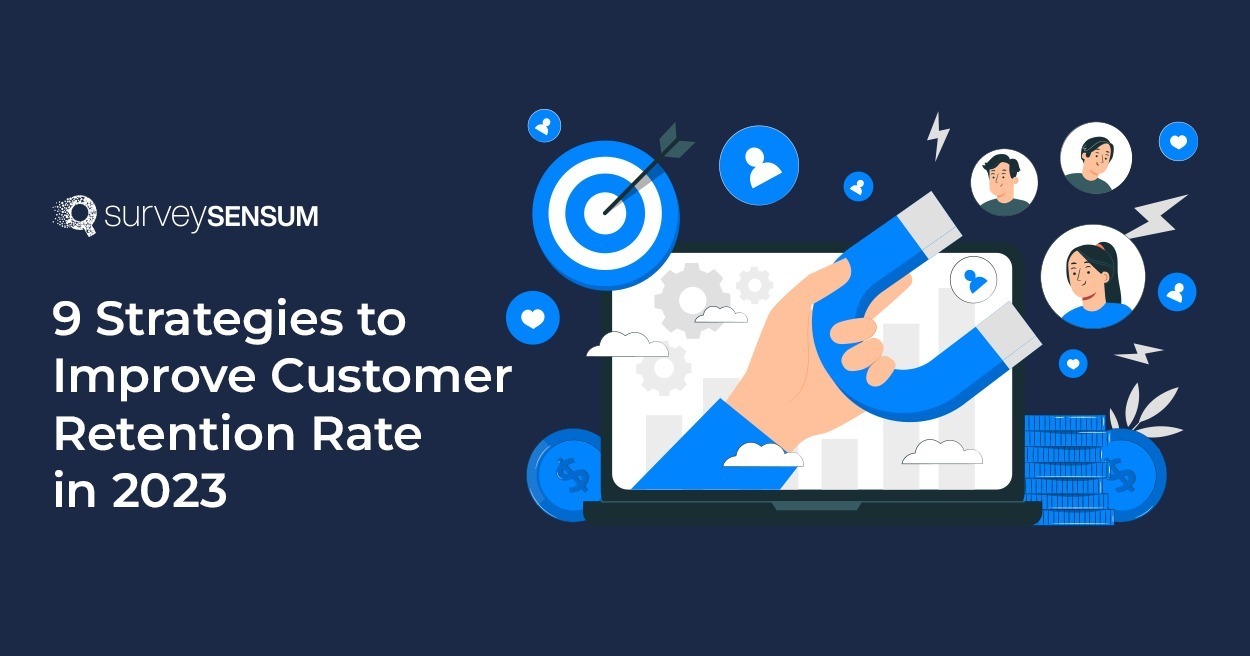
There are two companies A and B having similar numbers of customers and both want to increase their business.
Company A, decided to run a substantial marketing campaign, investing hundreds of dollars in hopes of acquiring new customers. Unfortunately, the campaign only yielded two customers, generating a total of $50 in business.
This shows the high cost of customer acquisition and how, at times, businesses fail to recoup their initial investment.
In contrast, Company B chose to focus on retaining its existing customer base by introducing loyalty programs. This strategic move resulted in doubling their business, showcasing the power of leveraging customer retention to drive growth.
Now, you might be wondering why this matters. Well, acquiring new customers can costs you five times more than keeping the ones you have. So, customer retention is indeed crucial. But there’s a vital step between wanting to retain customers and actually measuring your success – that’s where the Customer Retention Rate comes in.
Now when you understand and improve this rate by using a customer feedback platform then you can boost your business’s profitability. But what is it exactly?
Let’s explore that right here.
The customer retention rate measures how well a business retains customers over time, assessing its ability to prevent churn or customer switching.
In simple terms, it indicates how well a business satisfies its customer base, crucial for long-term success.
This metric impacts your business by:
Also, retaining customers not only lowers costs and stabilizes businesses during economic fluctuations but also boosts profits, reduces expenses, fosters brand loyalty, and helps gather valuable feedback for improvement.
Now that we know what the customer retention rate is, let’s have a glance at how to calculate it.
You can calculate the customer retention rate by following this formula:
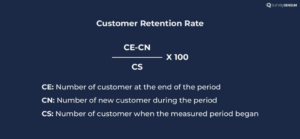
For instance, at the beginning of the year, your subscription-based software company had 1,000 customers (CS). Throughout the year, you acquired 200 new customers (CN). At the end of the year, you had 1,100 customers (CE).
To calculate the Customer Retention Rate (CRR) use the formula:
CRR = (CE – CN) / CS * 100
CRR = (1,100 – 200) / 1,000 * 100 = (900 / 1,000) * 100
CRR = 90%
So, your Customer Retention Rate for that month is 90%, indicating you kept 90% of your original customers.
Note: There is no point in calculating customer retention rate if you don’t understand the importance of customer churn on your business. So make sure you keep an eye on churned customers.
You must be happy with a 90% customer retention rate. But is it a good score?
A good CRR varies across industries but generally falls between 35%-84%. This indicates the ability to effectively retain and satisfy your customers. To understand this in-depth, a CRR
But what about below 70%?
Well, below 70% can be considered as a low score that shows improvement areas for your products. But it totally depends on your industry score. And what’s ‘good’ for you depends on factors like industry norms, competition, and business goals.
For instance, if your industry score is 68% and your score is 65% then you’re doing superb.
Note: A higher CRR typically indicates customer loyalty, trust, and a strong value proposition, while a lower one suggests potential churn and the need for enhanced customer engagement and service quality.
Increasing your CRR by just 5% can lead to a substantial profit boost of 25% to 95%. So, continuously monitoring and working to enhance your CRR is crucial for long-term business success.
That’s all about defining the customer retention rate, calculating it, and a good CRR. And now comes the strategies to enhance your CRR.
By implementing these 9 strategies, you can definitely improve your customer retention with VOC.
This statistic highlights the critical role of personalization in meeting customer expectations. In today’s diverse landscape, every customer seeks tailored experiences that align with their unique needs, preferences, and anticipations. Businesses must prioritize personalization to meet these expectations effectively.
So why not strengthen customer relationships with personalization?
Here’s how you can do it:
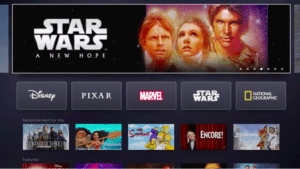
Disney+ is a prime example of how personalization transforms customer experience. It tailors content recommendations based on user’s preferences. This keeps subscribers engaged and loyal.
Forrester reports that 41% of customers expect email inquiries to be answered within six hours, yet just 36% of businesses meet this expectation.
This conveys the importance of delivering quick customer service to increase customer retention. When customers receive timely responses to their inquiries, it not only meets their expectations but also contributes significantly to customer satisfaction and retention.
Now, to help you excel in providing exceptional customer service, here are some practical tips:
Apple Inc. is renowned for its customer service. They are just a call away whenever a technical glitch with your iPhone happens. They not only solve it but leave you feeling valued. Apple goes further, sometimes replacing faulty devices with new ones. This commitment creates Apple enthusiasts, turning users into brand advocates.

Boost Customer Loyalty With NPS Surveys- Sign Up for Free
Have you ever visited a store where aisles are cluttered, labels are confusing, and no one assists you? Your experience must have been frustrating, right?
Similarly, in the digital age, your website is your storefront. If it’s complex and navigating feels like a puzzle, customers won’t stick around because they seek seamless experiences.
That’s why you should make it easy for your customers to interact with you. You can do that by following techniques:
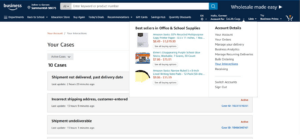
Amazon is a prime example of effortless business interactions. Their website is simple, and they excel in clear communication. Also, Amazon Prime offers speedy delivery, while returns are as easy as a few clicks. With diverse payment choices, Amazon caters to customers’ needs. This commitment has solidified Amazon as a retention champion.
Thus, simplify your business interactions to create a user-friendly haven, keeping customers coming back for more.
Loyalty programs are like a warm welcome-back hug for your customers. They say, “We appreciate you coming back!” The loyalty programs reward your customers for their repeat business.
So, how to do it?
You can do it by offering
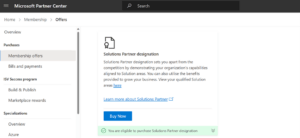
MPN is a loyalty program tailored for businesses offering Microsoft-based solutions. MPN partners gain access to a lot of valuable resources, training, marketing support, and technical assistance. This program shows how loyalty programs can be more than discounts; they can be a gateway to invaluable resources and growth opportunities.
By rewarding partners for their commitment, Microsoft strengthens its customer base while fostering expertise and collaboration within its network. This symbiotic relationship strengthens customer loyalty and drives business growth.
Successful brands maintain high customer retention rates by continually enhancing their products. They recognize that in the fast-moving tech world, standing still means falling behind.
Here’s how they do it:
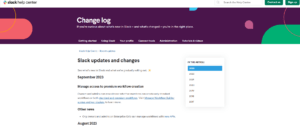
Slack is a popular team communication platform that maintains a high customer retention rate by continually enhancing its products. This commitment to improvement keeps customers engaged and satisfied.
Launch Product Surveys with SurveySensum – Sign Up For Free
When deciding to make a purchase, 81% of customers say that trust is an important factor in their decision. Building trust isn’t a one-size-fits-all tactic that any business can implement overnight.
So implement these practices to build relationships with your business customers:
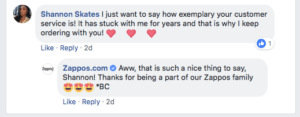
Zappos, the online shoe and clothing retailer, excels in building trust with customers. They engage personally, communicate regularly, show care, and provide easy contact options. This approach has made Zappos a trusted brand known for exceptional customer relationships.
Improving your business is a challenging task if you’re unaware of your customers’ sentiments. So, create an efficient VoC Program and start listening to them.
Here’s how you can do it?
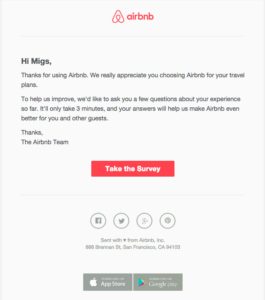
Airbnb, a global lodging platform, excels at listening to its users. They actively seek feedback through various channels, including online reviews and direct communication. Airbnb then takes swift action to improve user experiences based on this feedback. This approach has contributed significantly to the platform’s growth and success in building strong customer relationships.
Creating a sense of exclusivity and granting early access to your customers can work wonders in retaining their loyalty. It makes them feel like valued members of an exclusive club, fostering a deeper connection with your brand.
3 Tips to implement exclusivity and early access:
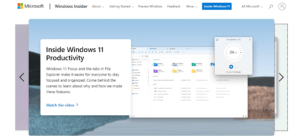
Microsoft’s “Windows Insider” program is a great example. It lets dedicated Windows fans try out new features and updates before everyone else. This makes them feel like they’re part of something special and keeps them loyal to Windows.
By involving customers in the software development process, Microsoft builds a strong community and gets helpful feedback. This exclusivity encourages Windows users to stay loyal and engaged with the brand.
The strategy of gamification is indeed a game changer to keep your customers hooked. It includes game-like elements, such as points, rewards, challenges, and competitions, in non-game contexts to engage and motivate people to achieve certain goals or perform specific actions.
Customers want more than a simple exchange of money; they seek experiences that go beyond the purchase. Gamification offers that extra layer of engagement, making them feel valued and entertained.
You can use gamification by:
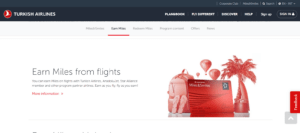
A brilliant example of this strategy is Miles & Smiles, an airline platform. They understand that travel isn’t just about reaching a destination; it’s about embracing the journey itself. They transform the travel experience by gamification.
Here’s how:
These tokens can be redeemed for exciting rewards like exclusive travel guides, surprise getaways, or even a dream holiday package.
That’s all. With these 9 strategies, you can for sure improve customer retention rate just like these real-life businesses.
With these 9 potent tips, you can have your customers coming back for more leading to an increase in both customer retention and your business. These are the real deal as you can see how famous brands are leveraging it.
So, implement these strategies in your business today and take customer experience to the next level.
Now, you might be wondering, “How do I get started?” Well, here’s your chance to book a demo with customer retention experts of SurveySensum. They can help you make your gathered customer feedback actionable and turn your customers into loyal fans.
